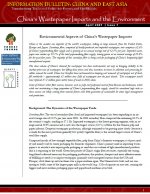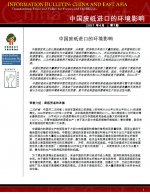ISSUE 7: ENVIRONMENTAL ASPECTS OF CHINA’S WASTEPAPER IMPORTS
English version
By B. Stafford View PublicationChina is the number one importer of the world’s wastepaper, taking in large amounts from the United States, Europe and Japan. Secondary fiber, comprised of locally-produced and imported wastepaper, now comprises 62.6% of China’s papermaking fiber supply and is growing at an annual average rate of 12.5% per year. Imported wastepaper now makes up 33.1% of the total papermaking fiber supply, having grown at an annual average of 29.8% for the past four years. The majority of this secondary fiber is being used for packaging of China’s burgeoning light manufactured exports. The sheer volume of China’s demand for wastepaper has been instrumental, not only in bringing stability to the
market price-wise of wastepaper, but lifting those prices and thus incentives to invest in collection and processing facilities around the world. China has therefore been instrumental in keeping vast amounts of wastepaper out of landfill worldwide — approximately 65 million tons (Mt) of wastepaper over the past decade. This wastepaper would have replaced 27.2 million green metric tones of wood in 2006 alone. Some of China’s other fiber sources, however, such as pulp and pulpwood sourced from Russia and Indonesia, which while not constituting a large proportion of China’s papermaking fiber supply, should be considered high risk as these sources are likely coming from natural forests with little guarantee of sustainable let alone legal management and production. (Also available in Chinese).


